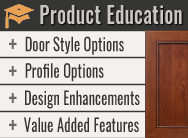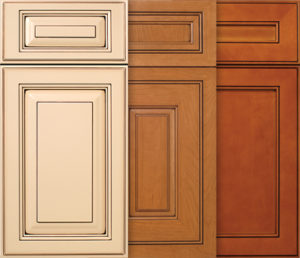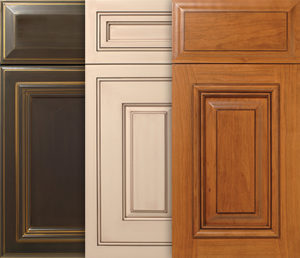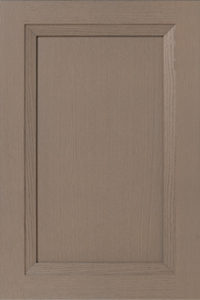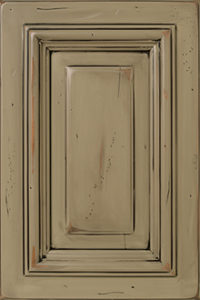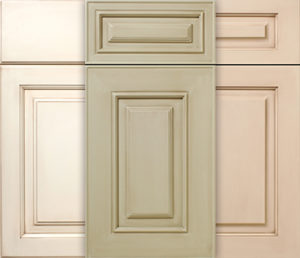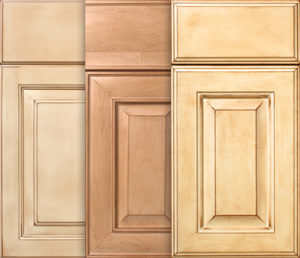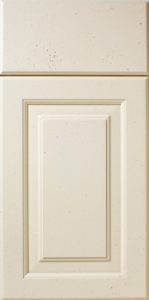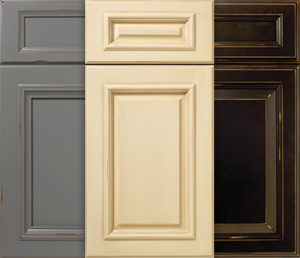Glazes Explained
WalzCraft Glazing Methods
Flow Pen (FP)
The “Flow Pen” method utilizes a flow pen glaze bottle to apply glaze to the detail in profiled areas only, such as a lip or crevice. It is not necessary to apply glaze to sheet stock unless your sheet stock has center panel face routing.
Not all profile and molding options are compatible with this glazing method. Moldings will only be glazed if there is an area for the glaze to rest. Please refer to our Website / Resources / Technical Information for compatible options. We will attempt to apply glaze to Accent Components to match the Flow Pen application as close as possible. Please note that it is not always possible to apply Flow Pen Glaze to every detail within a heavily profiled Accent Component. For the most consistent look across an entire order, we recommend using the “Dry Wiped” or “Solvent Wiped” glazing method on all products when ordering Accent Components. Flow Pen is not an option for Lattice Products.
Rustic Grades and products with Simulated Distressing or Renaissance Distressing will not have “Flow Pen” glaze added to any of the natural and simulated defects associated with these products. Our Flow Pen Glazing Application Drawings will show you where the glaze is applied to each profile.
Solvent Wiped - With Flow Pen (SWFP)
This method utilizes either a brush, rag, or spray gun to apply glaze to the entire face and profiled areas of the product. The glaze is then wiped away with a clean, dry cloth, leaving the glaze build up at the desired level of intensity before wiping with a rag soaked with mineral spirits, to achieve the desired look. Using a flow pen glaze bottle, glaze is then applied to the crevices, corners, and profiled areas. This method will result in a cleaner appearance than a “Dry Wiped” glaze.
The original color and wood species combination will vary slightly between the front and back side of the product. Due to the glazing effect, it becomes necessary to apply glaze to all sheet stock, moldings, and accent components.
Solvent Wiped - Without Flow Pen (SWNFP)
The “Solvent Wiped” method utilizes either a brush, rag, or spray gun to apply glaze to the entire face and profiled areas of the product. The glaze is then wiped away with a clean, dry cloth, leaving the glaze build in profiled areas of the product before wiping with a rag soaked with mineral spirits, to achieve the desired look. This method will result in a cleaner appearance than a “Dry Wiped” glaze.
The original color and wood species combination will vary slightly between the front and back side of the product. Due to the glazing effect, it becomes necessary to apply glaze to all sheet stock, moldings, and accent components.
Dry Wiped - With Flow Pen (DWFP)
This method utilizes either a brush, rag, or spray gun to apply glaze to the entire face and profiled areas of the product. The glaze is then wiped away with a clean, dry cloth, leaving the glaze build up at the desired level of intensity. Using a flow pen glaze bottle, glaze is then applied to the crevices, corners, and profiled areas.
This method will alter the appearance of the original color and wood species combination and will cause the color to vary between the front and back side of the product. Due to the glazing effect, it also becomes necessary to apply glaze to all sheet stock, moldings, and accent components.
Dry Wiped - Without Flow Pen (DWNFP)
The “Dry Wiped” method utilizes either a brush, rag, or spray gun to apply glaze to the entire face and profiled areas of the product. The glaze is then wiped away with a clean, dry cloth, leaving the glaze build in profiled areas of the product.
This method will alter the appearance of the original color and wood species combination and will cause the color to vary between the front and back side of the product. Due to the glazing effect, it also becomes necessary to apply glaze to all sheet stock, moldings, and accent components
Dry Wiped - Aged Look (DWAL)
The “Dry Wiped-Aged Look” method is similar to the “Dry Wiped – Without Flow Pen” method as both utilize either a brush, rag or spray gun to apply glaze to the entire face and profiled areas of the product. In each case, the glaze is then wiped away with a clean, dry cloth. The “Aged Look” is achieved by not wiping the door as completely or carefully, and results in a less uniform appearance from one area of the door to another, as well as from one door to another.
This method will alter the appearance of the original color and wood species combination and will cause the color to vary between the front and back side of the product. Due to the glazing effect, it also becomes necessary to apply glaze to all sheet stock, moldings, and accent components.
Dusted Methods
There are two options for achieving a desirable look with Dusted glaze. The first option, “Dusted” Method Solvent Wiped (DMSW), utilizes a spray gun to lightly apply glaze to the edges and face, focusing on the profiled areas. The glaze is allowed to set a short time before wiping with a clean, dry cloth dampened with mineral spirits. This method will alter the appearance of the original SolidTone® color and will cause a variation between the front and back side of the product. Due to the glazing effect, it becomes necessary to apply glaze to all refacing or sheet stock, moldings, and accent components. The glaze used for this method is unique to this process and is only available on the SolidTone® colors with a * behind them on page R2-1 of our Product Specifications Catalog. This option is only available with Graphite or Sand Dust Glaze.
The second option, “Dusted” Method Dry Wiped (DMDW), also utilizes a spray gun to lightly apply glaze to the edges and face, focusing on the profiled areas. The glaze is allowed to set a short time before it is wiped away with a clean, dry cloth, leaving the glaze build up at the desired level. This method will alter the appearance of the original SolidTone® color and will cause a variation between the front and back side of the product. Due to the glazing effect, it becomes necessary to apply glaze to all refacing or sheet stock, moldings, and accent components. The glaze used for this method is unique to this process and is only available on the SolidTone® colors with a * behind them on page R2-1 of our Product Specifications Catalog. This option is only available with Sand Dust Glaze.
Feathered Method (FM)
This method utilizes a fan brush to apply glaze to the edge and face, focusing heavily on the profiled areas. The excess glaze is removed from the fan brush with a dry cotton cloth before application to the product. This method of application involves lightly moving the brush back and forth in a quick manner so that the glaze is applied primarily to the higher areas of the profile. Several passes are necessary to achieve the look of this method.
This method will alter the appearance of the original stain and wood species combination and causes the color to vary between the front and back side of the product. Due to the glazing effect, it becomes necessary to apply glaze to all refacing or sheet stock, moldings, and accent components. Rub Through options are not available in conjunction with the Feathered Glaze Method. The glaze used for this method is unique to this process. This option is only available with Chocolate Glaze.
Simulated Fly Speck (FSM)
The “Fly Speck” glazing method utilizes a nylon brush to apply glaze randomly to the edge and face. This method of application involves standard wiping glaze which is applied to a nylon brush. The bristles are then pulled back and released quickly with the thumb, or “flicked”, sending the glaze off to the surface of the product in tiny droplets.
Due to the unique glazing effect, it becomes necessary to apply glaze to all refacing or sheet stock, moldings, and accent components. This method may be used alone with any stained or SolidTone® products and can be used in conjunction with all other glazing methods. This option is only available with Black Glaze.
Simulated Stiff Straight Brush (SSBM)
This method utilizes either a brush, rag, or spray gun to apply the glaze to the edge, face, and profiled areas of the product. The glaze is then wiped away with a dry cotton cloth, leaving the glaze build up at the desired level of intensity before wiping with a rag soaked with mineral spirits, to achieve the desired look. Wiping with the grain will leave simulated “stiff straight brush” lines in the product.
This method will alter the appearance of the original stain and wood species combination and causes the color to vary between the front and back side of the product. Due to the glazing effect, it becomes necessary to apply glaze to all refacing or sheet stock, moldings, and accent components. The glaze used for this method is unique to this process and is only available on the SolidTone® colors with a * behind them on page R2-1 of our Product Specifications Catalog. Coffee and Gray Glaze colors work best.
Rub Through Options
A Rub Through is similar to a Simulated Distressing Wear Mark. This technique is done after the Stain or SolidTone® color is applied and exposes the bare wood. After the Rub Through has been applied, you have the option of leaving this area raw or having a stain applied. Glazing is also available and will be applied to the entire part. Refer to Section R3 for additional information on glazing.
Rub Through Descriptions
RBT100 – The RBT100 is considered a heavy wear that will expose the bare wood beneath the stain or paint. Pronounced areas of wear are achieved with a combination of an orbital sander and scraper, which are applied in a random pattern to the inside and outside of the stiles and rails, corners of the raised center panel and corners of the center panel reveal of doors. Wear is not applied to flat center panels or sheet goods. These exposed areas may be left raw or they can be stained or glazed before finishing with a topcoat. RBT100 is not available on MDF products.
• See our Signature Series Design S581 Winfield
RBT200 – The RBT200 is considered a light wear that will expose the bare wood beneath the stain or paint. Areas of wear are achieved with a scraper, which is applied in a random pattern to the stiles, rails and center panel of doors. Wear is not applied to flat center panels or sheet goods. These exposed areas may be left raw or they can be stained or glazed before finishing with a topcoat. RBT200 is not available on MDF products.
• See our Signature Series Design S582 Angler
RBT300 – The RBT300 is a Rub Through “Look” that is achieved by applying a subtle mark to areas of a door or drawer front with a colored wax pencil. This technique is only available with light SolidTone® colors and is done after the color is applied. The RBT300 complements our “Dusted” glaze method.
• See our Signature Series Design S513 Carlton
Rub Through Options
Raw – The exposed Rub Through areas are left bare and finished with a topcoat.
• See our Signature Series Design S370 Geneva
Stained – The exposed Rub Through areas are stained, giving an aged look using any one of our “Wiping” stains and then finished with a topcoat. Staining is not necessary if you are ordering your product glazed.
• See our Signature Series Design S360 Darien
Glazed – Glaze will be applied to the entire door, including the exposed Rub Through areas, unless otherwise specified. Solvent Wiped and Dry Wiped glaze methods will alter the color of the bare wood and MDF material. The Flow Pen glaze method is not an option.

